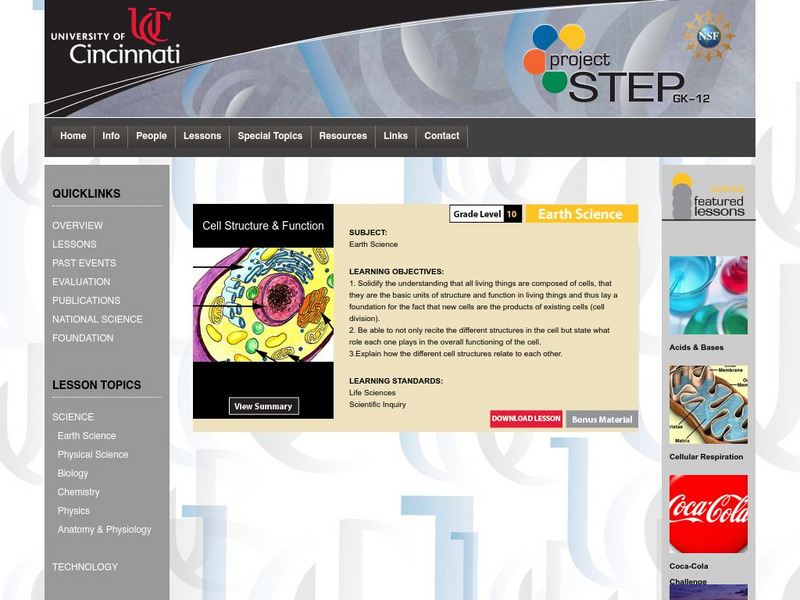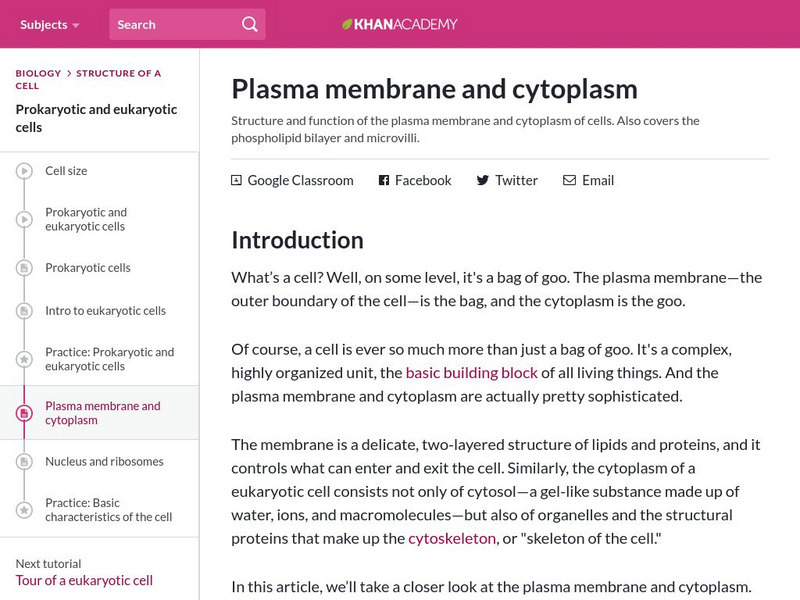Hi, what do you want to do?
Curated OER
Teaching Biotechnology With Models
Students are introduced to biotechnology by using models. The teacher uses A Sourcebook of Biotechnology Activities, Rasmussen and Matheson project co directors. One of the activities in the book is: students use a scale models to very...
Curated OER
Extraction of DNA from Onion
Students experiment with DNA by isolating it from plant tissue. They investigate whole onions to prepare DNA. They complete the experiment to examine the structural characteristics of DNA.
Curated OER
Cell Transformation in Tobacco Leaf Disks
Students review the basic principles of plant cell structure, tissue culture, sterile technique, and cell transformation. Next students complete a plant transformation experiment using whole plant material in order to view evidence of...
Curated OER
Generation of Action Potentials in Nitella Giant Algal Cells
Students observe cytoplasmic streaming in Nitella cells. They examine the conduction of a wave of depolarization across other membranes, such as the axons of neurons. Students predict the effects of sending a small electric current...
Curated OER
The Journey of a Red Blood Cell
Fifth graders examine how a red blood cell travels throughout the body. Using a model, they follow the flow of blood throughout the entire body. They identify the functions of the lungs and discuss the difference of the blood entering...
Curated OER
Study of the Cell
Students draw a diagram to show the fluid mosaic model of a membrane. They explain how hydrophobic and hydrophilic properties help membranes hold their shape. They identify the functions of different cell membrane proteins as well.
Curated OER
"Attack A Cell, Any Cell" Disease Unit
Seventh graders use the Internet to gather information about a disease. They also discuss in groups how diseases are a worldwide problem and brainstorm ideas they can help. They create an informational packet on the disease they researched.
Curated OER
Notes on Cell Organelles
Students record information and write journal entries on the structure and function of cell organelles while viewing a Powerpoint presentation.
Curated OER
Plant And Animal Cells
Students identify parts of plant and animal cells and describe the functions of each part. They distinguish between plant and animal cells. After a lecture/demo, students perform experiments which help them construct models of plant and...
Curated OER
The Inside Story- Cells, Organs, and Systems of the Human Body
Fourth graders study the human body from cell level to the inter-relationships of the systems in this unit. Students practice study skills throughout the unit.
Curated OER
What Makes Me Who I Am?
Fifth graders analyze their genetics and look closely at cell interaction within their bodies in this unit. Students publish and share picture books.
Georgia Department of Education
Ga Virtual Learning: Biology: The Study of Life
A learning module where students analyze the relationships between the structures and functions of cells, tissues, organs to carry out all of the requisite characteristics of life. They also describe the scope of biological study and...
Biotechnology Institute
Biotechnology Institute: Your World: Fighting Cancer With Biotechnology [Pdf]
This Biotechnology Institute issue focuses on the role of genetics in cancer. Find out about several types of cancer, the risks, treatments available now, and the treatments of the future.
University of California
Organic Structures:the Architecture of Life
Article discusses how objects in nature are held together through balanced forces. Scroll midway down to find info on microtubules and microfilaments. Links to excellent electron micrographs.
Yale University
Yale University Center for Structural Biology
This site is an excellent resource on the research and graduate studies programs in the field of biophysics.
TED Talks
Ted: Ted Ed: Cell vs. Virus: A Battle for Health
All living things are made of cells. In the human body, these highly efficient units are protected by layer upon layer of defense against icky invaders like the cold virus. This learning module takes a journey into the cell, introducing...
About Kids Health
About Kids Health: How the Body Works: Genetics
Learn all about genetics and how it works in this interactive teaching aid that highlights the study of genes using colorful animated illustrations.
University of Colorado
University of Colorado: Ph Et Interactive Simulations: Gene Expression the Basics
Generate and collect three types of proteins, then move on to explore the factors that affect protein synthesis in a cell.
Other
Department of Biophysics & Biophysical Chemistry
Johns Hopkins University School of Medicine site detailing ongoing research in Biophysics & Biophysical Chemistry. The site has links to courses, seminars, faculty, graduate studies, and general information.
Other
University of Cincinnati: Project Step: Cell Structure and Function
Engaging, interactive lesson plan focusing on cells being the basic units of structure and function of all living things. Students will be able to explain the different roles of each structure and how they relate to each other.
CK-12 Foundation
Ck 12: Episd: Prokaryotic and Eukaryotic Cells
[Free Registration/Login may be required to access all resource tools.] Examine prokaryotic and eukaryotic cells to be able to distinguish between the two as well as be able to give examples of both cell types.
CK-12 Foundation
Ck 12: Cell Mediated Immune Response
[Free Registration/Login may be required to access all resource tools.] Do cells really attack other cells? They sure do. When they can, the T cells search out and destroy "bad" cells. In the following tutorial students will identify the...
CK-12 Foundation
Ck 12: Characteristics of Life
[Free Registration/Login may be required to access all resource tools.] Videos, texts, activities, and assessments about the factors that characterize living things.
Khan Academy
Khan Academy: Plasma Membrane and Cytoplasm
Article takes an in-depth look at the structure and function of the plasma membrane and cytoplasm of cells, the phospholipid bilayer, and microvilli.

















![Biotechnology Institute: Your World: Fighting Cancer With Biotechnology [Pdf] Article Biotechnology Institute: Your World: Fighting Cancer With Biotechnology [Pdf] Article](https://static.lp.lexp.cloud/images/attachment_defaults/resource/large/FPO-knovation.png)










